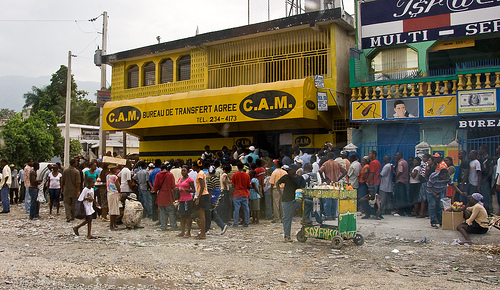With phone lines being restored in Haiti, money sent from families abroad “by wire” is again arriving, and helping reconstruction even where international aid has not arrived. Remittances from family members living abroad represented at least thirty percent of Haiti's Gross National Product before the January 12 earthquake.
The two largest Haitian communities outside Haiti are those in the Dominican Republic and the United States. Between 400 thousand and 600 thousand Haitian citizens call each of the neighboring nations home. Another 80-100 thousand live in other Caribbean nations or in France. This chart from the Inter-American Development bank, based on a 2006 study, claims that Haitians living in the United States sent nearly $1.9 billion home annually.
The collapse of telephone service and, in some cases the buildings that housed banks and remittance offices, had temporarily cut off that money. But this week long lines were visible outside money transfer offices, such as this CAM office in Carrefour, southeast of Port au Prince, photographed by GV's Georgia Poppelwell.

Though the capital has received the bulk of media attention, it's not necessarily where the money sent by family members abroad will arrive. The International Association of Money Transfer Networks, an industry association which represents companies that carry electronic money transfers, says that about half the funds wired to Haiti from the US, the largest source of remittances, is sent to rural areas. That's significant because those areas are also seeing an increase in population, as people displaced by the quake go to live with family and friends in hometowns and less-damaged areas.
Dilip Ratha, a World Bank economist, argues at the bank's blog that remittances could hold a more important role with the emergency extension of “temporary protected” immigration status (“TPS) to as many as 200 thousand Haitians living in the US.
If the TPS resulted in a 20 percent increase in the average remittance per migrant, we would expect an additional $360 million remittance flows to Haiti in 2010! What is more, if the TPS were to be extended once beyond the currently stipulated 18 months – the extension is almost certain to happen, judging by the history of extensions of the TPS for El Salvador, Honduras, Nicaragua, Somalia and Sudan – additional fund flows to Haiti would exceed a billion dollar over three years. That would be a billion dollar of financial help coupled with goodwill and advice, tailored to the needs of the recipient. Financial help in the form of remittances from family members abroad is always the first to arrive in times of distress. Remittances to Haiti this year will surge, as they have done whenever and wherever there has been a crisis or natural disaster







1 comment